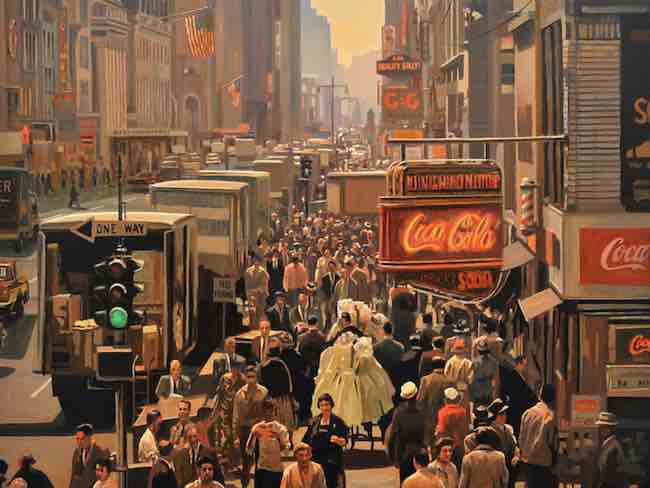Il desiderio di riprodurre la realtà così come osservata si unisce in alcuni artisti a uno sguardo quasi nostalgico nei confronti di un passato relativamente recente da poter appartenere all’immaginario comune eppure così diverso da indurre a ripercorrere i frangenti di esistenza di una generazione per cui i valori, l’entusiasmo e la voglia di costruire qualcosa di nuovo era forse più intensa, meno annoiata, più coinvolta rispetto al vivere della società attuale. Il protagonista di oggi racconta di un periodo storico particolare, quello del secondo dopoguerra, di cui riesce a lasciar fuoriuscire l’atmosfera ottimista, brulicante di cose da fare e traguardi da ottenere che aveva investito il mondo intero, ma in particolar modo gli Stati Uniti, in quell’epoca.
A seguito del lungo ventennio del distacco dalla realtà osservata che si concretizzò con tutti quei movimenti di rottura con il passato artistico precedente e che si orientarono verso l’astrazione, come il De Stijl, il Suprematismo, l’Astrattismo Geometrico, il Concettualismo e la Bauhaus, oppure verso un’adeguazione della forma conosciuta al mondo del sogno e dell’incubo, come il Surrealismo, o della scomposizione scientifica e analitica dell’immagine, come nel Cubismo, vi fu negli anni successivi il desiderio di un ritorno all’ordine, al recupero di un approccio più tradizionale alla pittura pur senza però dimenticare l’approfondimento verso l’essere umano avvenuto prima con l’Espressionismo e poi con il Surrealismo, superando pertanto la tendenza a fermarsi alla perfezione dell’immagine tipica del Realismo del Diciannovesimo secolo. Proprio negli Stati Uniti, si delineò una corrente pittorica che mise l’Esistenzialismo al centro della sua ricerca e della sua osservazione e che prese il nome di Realismo Americano, la quale ebbe tra i suoi massimi rappresentanti Edward Hopper che raccontò affascinanti spaccati di vita della middle class statunitense in cui ciò che emergeva era per l’appunto il senso di solitudine, vissuto negli interni delle villette, ai bordi delle piscine o nei locali notturni, quell’incapacità di godere appieno del benessere ottenuto perché spesso chiuse in se stesse dal punto di vista umano. La riflessione sull’esistenza di quel periodo, così come la malìa di una società elegante, rispettosa dei valori importanti, e le atmosfere magiche degli anni Cinquanta, sono tutt’ora protagonisti della pittura di alcuni tra i maggiori artisti figurativi del nostro secolo, uno tra tutti Jack Vettriano che racconta ambientazioni fumose, rarefatte, in cui l’uomo e la donna dell’epoca sono raffigurati in tutta la loro raffinatezza, nel loro formalismo che era molto vicino al rispetto verso se stessi e verso gli altri, quell’essere sospesi in un tempo in cui tutto sembrava essere più bello e meno complesso rispetto al presente. Tanto concentrato sugli esterni e sulla socialità di un’epoca lontana è Vettriano, quanto invece più orientati a riprodurre gli interni, l’intimità di stanze con vista sui grattacieli, o lo charme dei locali di musica dal vivo, sono altri due grandi esponenti del movimento, Brent Lynch e Myles Sullivan, entrambi in grado di mettere in evidenza il glamour della vita di molti decenni fa nelle grandi città americane. L’artista di origini italiane, ma di fatto cittadino del mondo, Paolo Paradiso, dà un punto di vista differente sulla società statunitense degli anni Cinquanta, racconta il senso di comunità, l’operosità e il desiderio di crescita e di progresso che si respirava in quel periodo fatto di ottimismo, di consapevolezza di poter costruire il nuovo, di poter creare nuovi approcci, nuovi punti di vista, un nuovo modo di vivere orientato alla positività e all’ottimismo verso il futuro.
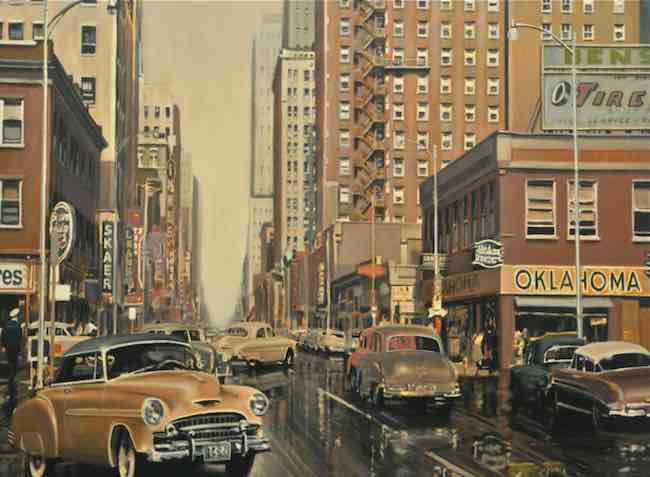
Le sue opere inquadrano in straordinari fermo immagine il mondo vivace e dinamico delle città statunitensi, in particolar modo New York, che di fatto ha sempre costituito il traino economico e finanziario degli Stati Uniti, e ne riproduce i dettagli, il caos delle automobili e dei taxi, il via vai delle persone che affollavano le sue strade, tutte impegnate a dare il proprio contributo per rendere grande il paese; non c’era rivalità e competizione in quel periodo, piuttosto la consapevolezza che solo attraverso lo sforzo comune sarebbe stato possibile raggiungere il migliore risultato per tutti.
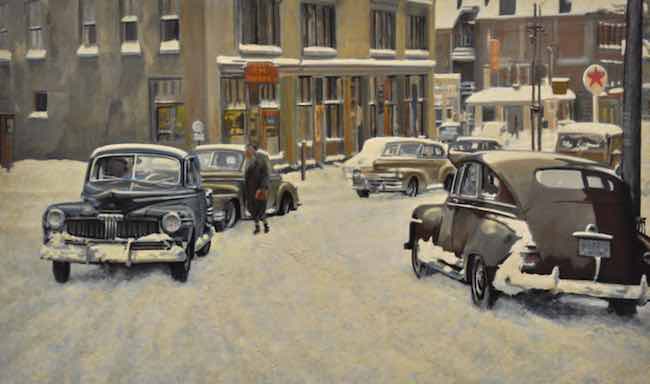
E Paolo Paradiso infonde questa sensazione nell’osservatore delle sue opere illuminando i panorami urbani di una luce chiara, contrapposta alle tonalità tendenti al rame e all’ocra necessarie per raccontare il passato, come se attraverso di essa volesse sottolineare la dinamicità, la fiducia diffusa nell’idea comune e la consapevolezza che il peggio fosse alle spalle. Le città sono le vere protagoniste dei dipinti, con i loro palazzi, con le loro strade brulicanti di vita, con la loro immortale bellezza; sembrano mettersi in posa, offrire all’artista il lato migliore per mostrare quanto in fondo la loro presenza sopravviva all’essere umano, costituendo un posto accogliente che solo negli anni successivi è stato trasformato e a volte modificato nella sua essenza proprio a causa di un progredire della società non sempre nella direzione migliore.
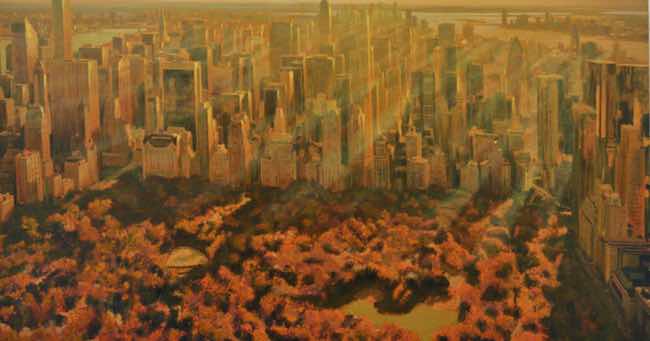
Ciò che affascina Paolo Paradiso, a differenza dei suoi colleghi appartenenti al Realismo Americano e poc’anzi citati, non è l’esistenza del singolo con le sue sensazioni, le sue emozioni e a volte l’incertezza del vivere, bensì la comunità, quell’insieme sfaccettato di vite che si intrecciano, che interagiscono le une con le altre spesso senza neanche conoscersi eppure generando quell’affascinante atmosfera che fuoriesce dalle sue tele e che contraddistingue la sua intera produzione artistica.
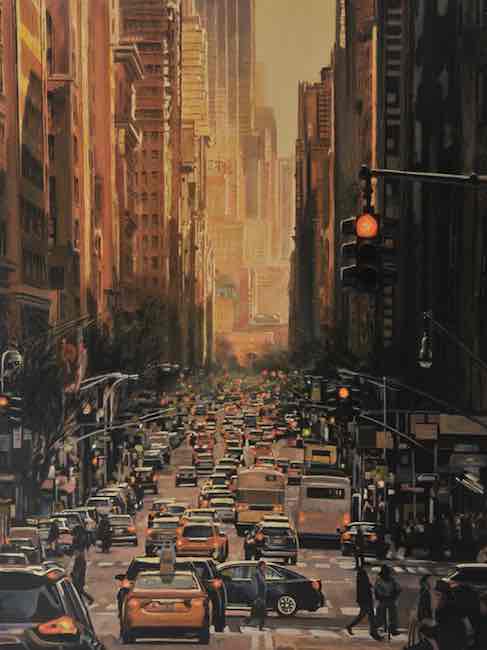
In Stop it’s red (Fermati è rosso) l’artista dirige lo sguardo dell’osservatore verso il traffico tipico delle giornate newyorkesi, allora come oggi, descrivendone i dettagli non solo delle auto sulla parte più bassa della tela bensì anche dei palazzi che si affacciano sulla via, della luce soffusa che entra insinuandosi tra i grattacieli e che contribuisce a infondere magia a quel panorama urbano, quasi come se sotto vi fosse un assordante rumore che viene attutito in alto dalla presenza di quei raggi di sole filtrante e in grado di rendere il caos più ordinato, meno fastidioso.
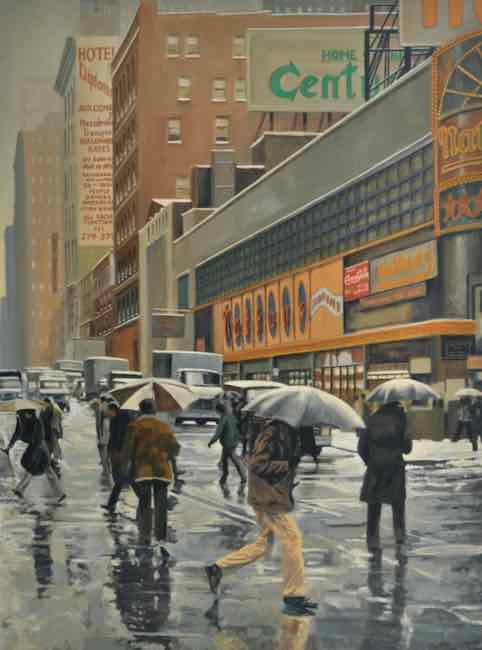
Nell’opera After the snow (Dopo la neve) invece Paradiso riproduce uno scorcio di vita che segue un evento atmosferico comune in una città del nord, eppure comunque in grado di destabilizzare la routine quotidiana, di rallentare i ritmi frenetici di un luogo che corre veloce verso il futuro; le persone sotto gli ombrelli si affrettano per raggiungere il calore dei luoghi di lavoro e ciò che emerge in modo chiaro è il silenzio ovattato che l’artista riesce a trasmettere, quella calma generata da una paralisi temporanea in grado di permettere di osservare tutto da un punto di vista differente, più tranquillo, più calmo sebbene gli individui sembrano non essere consapevoli di quella impensabile opportunità. In questo dipinto la città sembra cedere la scena alle persone, come se in qualche modo l’esortazione fosse quella di approfittare di un momento di quiete momentanea e di fermarsi a godere il bello di ciò che è intorno, anche se di fatto non sembra rivestire importanza per i protagonisti immortalati, come se la neve fosse solo un ostacolo ai loro ritmi.
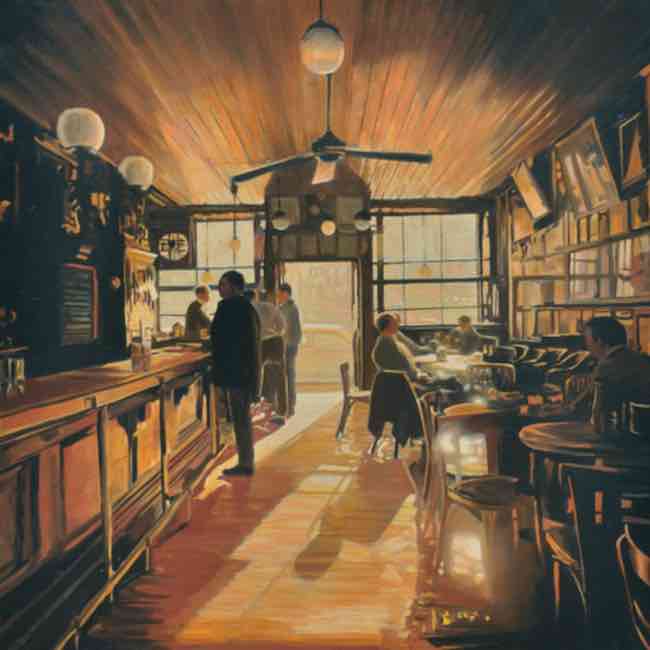
E proprio sull’esistenza delle persone Paradiso si sofferma in alcune opere, pur tuttavia avendo un punto di vista ampio, discreto, quasi come se mostrasse rispetto per l’intimità di ciascuno e per questo preferendo guardare da lontano, senza andare a indagare su nessuno in particolare piuttosto restando sul campo largo per lasciar emergere la totalità, il senso generale dell’ambiente descritto, come nella tela Morning drinker (Bevitori del mattino) in cui riproduce gli interni di un bar all’interno del quale gli uomini d’affari si soffermano prima di entrare in ufficio, oppure per fare una pausa, o ancora per prolungare una notte brava da cui fanno fatica a distaccarsi.
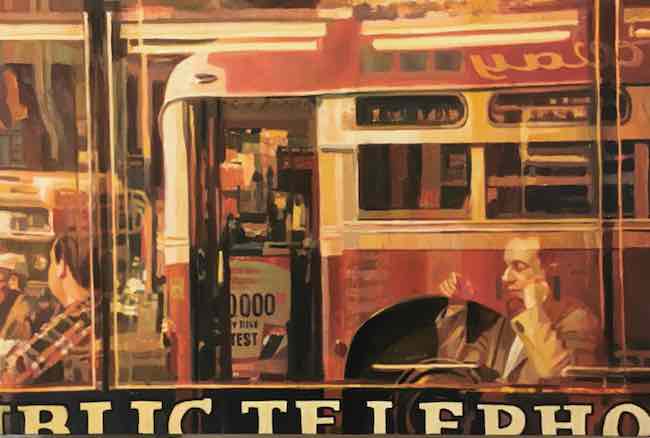
C’è tutto il bel vivere degli anni Cinquanta nelle opere di Paolo Paradiso che mostra uno sguardo nostalgico, ammirato verso la semplicità, la sicurezza del vivere, la positività di un mondo più tranquillo, meno pericoloso, più solidale malgrado la tendenza a ignorare l’altro che inevitabilmente da sempre contraddistingue le città metropolitane; le insegne, le marche più note che sono sopravvissute fino ai nostri giorni o quelle che invece si sono estinte perché non hanno saputo stare al passo con i cambiamenti, sono protagoniste tanto quanto i palazzi e le vie di New York, infondendo nell’osservatore la stessa nostalgia provata dall’artista. Paolo Paradiso ha all’attivo numerose mostre in tutto il mondo, vanta molti collezionisti negli Stati Uniti, paese dove ha vissuto a lungo, in Italia, dove è rappresentato dalla Galleria Ponte Rosso di Milano, e in molte altre nazioni nel mondo.
PAOLO PARADISO-CONTATTI
Email: a.consonni@ponterosso.com
Sito web: http://www.paoloparadiso.com/
Instagram: https://www.instagram.com/paoloparadiso_artist/
The fascination of the 1950s in the urban visions of American Realism by Paolo Paradiso
The desire to reproduce reality as it is observed is combined in some artists with an almost nostalgic look at a past that is relatively recent enough to belong to the common imagination and yet so different as to induce them to retrace the fringes of existence of a generation for which the values, enthusiasm and desire to build something new was perhaps more intense, less bored, more involved than the way society lives today. Today’s protagonist recounts a particular period in history, that of the post-World War II period, of which he succeeds in letting go of the optimistic atmosphere, teeming with things to do and goals to be achieved, that had affected the entire world, but especially the United States, at that time.
Following the long twenty-year period of detachment from observed reality that materialised with all those movements that broke with the previous artistic past and moved towards abstraction, such as De Stijl, Suprematism, Geometric Abstractionism, Conceptualism and the Bauhaus, or towards an adaptation of known form to the world of dreams and nightmares, such as Surrealism, or of the scientific and analytical decomposition of the image, as in Cubism, there was in later years a desire for a return to order, to the recovery of a more traditional approach to painting without, however, forgetting the deepening towards the human being that had occurred first with Expressionism and then with Surrealism, thus overcoming the tendency to stop at the perfection of the image typical of 19th century Realism. It was precisely in the United States that emerged a pictorial current that placed Existentialism at the centre of its research and observation and that took the name of American Realism. One of its greatest representatives was Edward Hopper, who portrayed fascinating slices of life of the American middle class in which what emerged was precisely the sense of loneliness, experienced in the interiors of cottages, by the side of swimming pools or in nightclubs, that inability to fully enjoy the well-being obtained because they were often closed in on themselves from a human point of view.
The reflection on the existence of that period, as well as the malice of an elegant society, respectful of important values, and the magical atmospheres of the 1950s, are still protagonists of the painting of some of the major figurative artists of our century, one of whom is Jack Vettriano, who depicts smoky settings, rarefied, in which the man and woman of the time are depicted in all their refinement, in their formalism that was very close to respect for themselves and others, that being suspended in a time when everything seemed to be more beautiful and less complex than in the present. Just as focused on the exteriors and sociality of a bygone era is Vettriano, how much more oriented towards reproducing interiors, the intimacy of rooms with a view of skyscrapers, or the charm of live music venues, are two other great exponents of the movement, Brent Lynch and Myles Sullivan, both of whom are able to highlight the glamour of life of many decades ago in the great American cities. The artist of Italian origin, but in fact a citizen of the world, Paolo Paradiso, gives a different point of view on American society in the 1950s, recounting the sense of community, the industriousness and the desire for growth and progress that was in the air at that time, made up of optimism, the awareness of being able to build the new, to create new approaches, new points of view, a new way of life oriented towards positivity and optimism towards the future. His artworks frame in extraordinary still images the lively and dynamic world of American cities, especially New York, which in fact has always been the economic and financial driving force of the United States, and reproduce its details, the chaos of cars and taxis, the hustle and bustle of the people who crowded its streets, all committed to making the country great; there was no rivalry and competition at that time, rather the awareness that only through common effort would it be possible to achieve the best result for all.
And Paolo Paradiso instils this feeling in the observer of his artworks by illuminating the urban panoramas with a clear light, as opposed to the copper and ochre tones needed to narrate the past, as if through it he wanted to emphasise the dynamism, the widespread trust in the common idea and the awareness that the worst was behind. Cities are the real protagonists of the paintings, with their buildings, their streets teeming with life, their immortal beauty; seem to pose, offering the artist their best side to show how much their presence basically survives the human being, constituting a cosy place that only in later years has been transformed and sometimes changed in its essence precisely because of a progression of society not always in the best direction. What fascinates Paolo Paradiso, unlike his colleagues belonging to American Realism and mentioned earlier, is not the existence of the individual with his feelings, emotions and sometimes the uncertainty of living, but rather the community, that multifaceted ensemble of lives that intertwine, interacting with the other often without even knowing him and yet generating that fascinating atmosphere that emerges from his canvases and that characterises his entire artistic production. In Stop it’s red, the artist directs the observer’s gaze towards the typical traffic of New York days, then as now, describing the details not only of the cars on the lower part of the canvas but also of the buildings that overlook the street, of the soft light that creeps in between the skyscrapers and helps to infuse that cityscape with magic, almost as if there were a deafening noise underneath that is muffled above by the presence of those filtering rays of sunlight that make the chaos more orderly, less annoying. In the painting After the snow, on the other hand, Paradiso reproduces a glimpse of life following an atmospheric event that is common in a northern city, yet still capable of destabilising the daily routine, of slowing down the frenetic rhythms of a place that is rushing towards the future; people under umbrellas hurry to reach the warmth of their workplaces, and what emerges clearly is the muffled silence that the artist manages to convey, that calm generated by a temporary paralysis capable of allowing everything to be observed from a different point of view, quieter, calmer, even though the individuals seem to be unaware of that unthinkable opportunity. In this painting, the city seems to cede the scene to the people, as if somehow the exhortation was to take advantage of a moment of momentary stillness and to stop and enjoy the beauty of what is around, even if in fact it does not seem to be of any importance to the protagonists immortalised, as if the snow were merely an obstacle to their rhythms.
And it is precisely on the existence of the people that Paradiso dwells in some of his paintings, although he has a broad, discreet point of view, almost as if showing respect for the intimacy of each person, preferring to look from a distance, without going to investigate anyone in particular, rather remaining in the wide field to let the totality emerge, the general sense of the environment described, as in the painting Morning drinker in which he reproduces the interior of a bar in which businessmen linger before entering the office, or to take a break, or even to prolong a night out from which they find it difficult to detach themselves. There is all the good living of the 1950s in Paolo Paradiso’s artworks, which show a nostalgic, admiring glance at the simplicity, the safety of living, the positivity of a quieter, less dangerous, more supportive world despite the tendency to ignore the other that has always inevitably characterised metropolitan cities; the signs, the best-known brands that have survived to the present day or those that have died out because they have not been able to keep up with the changes, are as prominent as the buildings and streets of New York, instilling in the observer the same nostalgia felt by the artist. Paolo Paradiso has numerous exhibitions all over the world to his credit. He has many collectors in the United States, where he has lived for a long time, in Italy, where he is represented by the Ponte Rosso Gallery in Milan and in several other countries worldwide.


